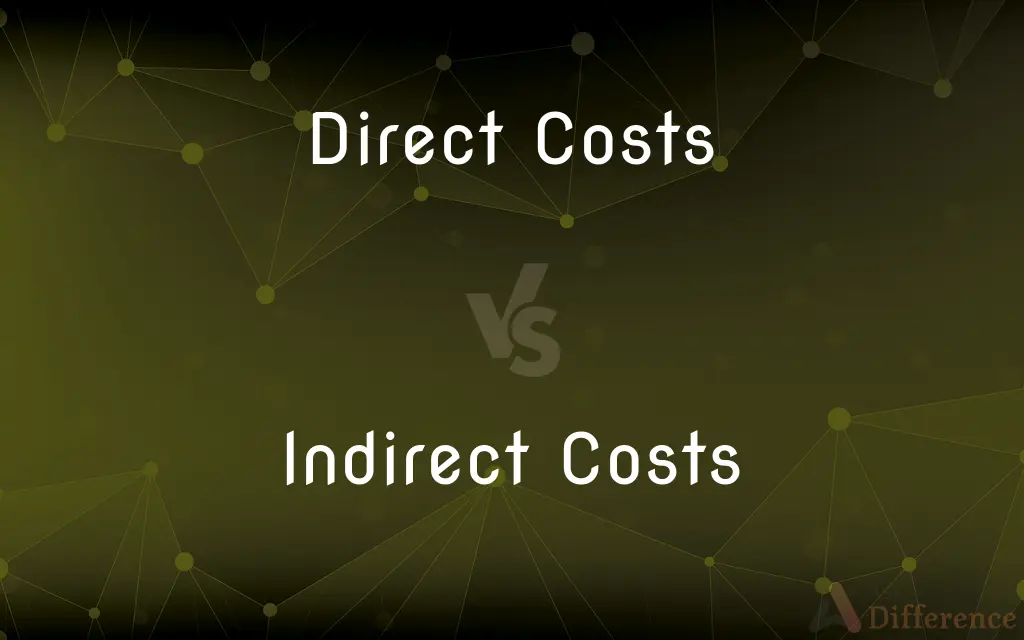Direct Costs vs. Indirect Costs — What's the Difference?
By Tayyaba Rehman — Published on November 1, 2023
Direct Costs are expenses directly attributable to specific projects or products, while Indirect Costs are overhead expenses not tied to a specific project or product.

Difference Between Direct Costs and Indirect Costs
Table of Contents
ADVERTISEMENT
Key Differences
Direct Costs are easily identified and associated with particular projects, tasks, or products. This type of cost can be traced back to a specific activity without ambiguity. For example, the cost of materials used in manufacturing a product or wages of workers on a specific project fall under Direct Costs.
Indirect Costs, conversely, are the expenditures that can't be attributed directly to a specific project or product. These are the overhead expenses that a business incurs irrespective of the specific activities undertaken. Utilities, rent, and administrative salaries are examples of such costs, as they benefit multiple projects or products and can't be attributed to just one.
The distinction between Direct Costs and Indirect Costs is crucial for accurate financial accounting and management. This differentiation helps businesses determine the actual cost of producing a specific product or service, ensuring precise pricing and profit calculations. Without separating these costs, a company might undervalue or overvalue its products.
Another vital consideration is the treatment of these costs during taxation. Some Direct Costs can be capitalized, turning into assets and depreciating over time. Indirect Costs, however, are often treated differently, with various rules for deductions based on tax laws. Accurate categorization ensures compliance and optimal fiscal strategies.
Comparison Chart
Association
Directly linked to a project or product.
Not directly linked to any specific project.
ADVERTISEMENT
Examples
Raw materials, labor for a specific task.
Rent, utilities, general office salaries.
Traceability
Easily traceable to a specific activity.
Difficult to trace to a specific activity.
Financial Impact
Affect the profitability of specific products.
Affect the overall profitability of a company.
Tax Treatment
Can often be capitalized and depreciated.
Typically deducted as current business expenses.
Compare with Definitions
Direct Costs
Costs that can be directly tied to a specific project or product.
The lumber used in furniture-making is a Direct Cost for the furniture company.
Indirect Costs
Costs that support the overall business operation but aren't tied to a particular revenue-generating activity.
Office stationery expenses are Indirect Costs, as they support multiple departments.
Direct Costs
Costs that have a clear and direct correlation with a business activity.
The paint used in producing a batch of toys is a Direct Cost.
Indirect Costs
Overhead expenses that remain relatively constant irrespective of production levels.
Whether producing 100 or 1,000 units, the company's rent remains an Indirect Cost.
Direct Costs
Expenditures that vary based on production or project scale.
As production increased, the Direct Costs of raw materials also rose.
Indirect Costs
Charges that, while essential for a business, can't be allocated to a single activity.
The expenses on general maintenance of machinery are Indirect Costs.
Direct Costs
Expenses that can be attributed exclusively to a particular activity.
The salary of a project manager overseeing a specific construction is a Direct Cost.
Indirect Costs
Costs that are not directly attributable to a specific product or project.
The monthly electricity bill, catering to the entire factory, is an Indirect Cost.
Direct Costs
Charges that are exclusive to a particular department, project, or product.
The costs of specialized software for a particular project are Direct Costs.
Indirect Costs
Expenditures that are spread out over multiple projects or products.
The salary of the CEO, overseeing multiple projects, is an Indirect Cost.
Common Curiosities
What's the main difference between Direct Costs and Indirect Costs?
Direct Costs can be traced to a specific project or product, while Indirect Costs are general overhead expenses.
Can labor be both a Direct Cost and an Indirect Cost?
Yes, labor for a specific project is a Direct Cost, while general administrative salaries are Indirect Costs.
Are Indirect Costs fixed?
Not necessarily. While some are fixed, like rent, others can vary, like utility bills.
Are Direct Costs always variable costs?
Often, but not always. Some Direct Costs can remain fixed over a range of production levels.
How do companies allocate Indirect Costs to products or services?
Through various methods like activity-based costing or traditional allocation based on direct labor hours.
How does tax treatment differ between Direct and Indirect Costs?
Direct Costs might be capitalized, while Indirect Costs are usually treated as expenses.
Why is distinguishing between Direct and Indirect Costs essential for businesses?
It helps in accurate costing, pricing, budgeting, and tax planning.
How do Indirect Costs impact a company's profit margin?
High Indirect Costs can lower profit margins as they don't increase with raised production or sales.
Can Direct Costs change over time?
Yes, Direct Costs can vary based on factors like volume of production or scope of a project.
Can the same cost be a Direct Cost for one company and an Indirect Cost for another?
Yes, context matters. For instance, a computer for a software development firm (used in production) might be a Direct Cost, but an Indirect Cost for a furniture manufacturing company.
Can Indirect Costs impact pricing?
Yes, accurate allocation of Indirect Costs ensures products are priced profitably, covering all overheads.
Are Direct Costs more controllable than Indirect Costs?
Generally, Direct Costs, tied to specific outputs, can be more easily controlled than the broader Indirect Costs.
How do startups often view Indirect Costs?
Startups often see high Indirect Costs as they establish operations but don't yet have high sales volumes.
Can technology aid in tracking Direct and Indirect Costs?
Absolutely. Various accounting and project management software help track and allocate both cost types effectively.
How do Direct Costs and Indirect Costs relate to profit and loss statements?
Direct Costs are deducted from revenue to calculate gross profit, while Indirect Costs are subtracted to determine net profit.
Share Your Discovery

Previous Comparison
Customer Expectation vs. Customer Perception
Next Comparison
Bullmastiff vs. French MastiffAuthor Spotlight
Written by
Tayyaba RehmanTayyaba Rehman is a distinguished writer, currently serving as a primary contributor to askdifference.com. As a researcher in semantics and etymology, Tayyaba's passion for the complexity of languages and their distinctions has found a perfect home on the platform. Tayyaba delves into the intricacies of language, distinguishing between commonly confused words and phrases, thereby providing clarity for readers worldwide.












































